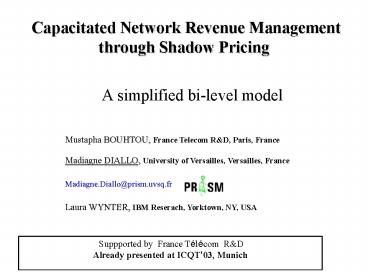Capacitated Network Revenue Management through Shadow Pricing PowerPoint PPT Presentation
1 / 19
Title: Capacitated Network Revenue Management through Shadow Pricing
1
Capacitated Network Revenue Management through
Shadow Pricing
- A simplified bi-level model
Mustapha BOUHTOU, France Telecom RD, Paris,
France Madiagne DIALLO, University of
Versailles, Versailles, France Madiagne.Diallo_at_p
rism.uvsq.fr Laura WYNTER, IBM Reserach,
Yorktown, NY, USA
Suppported by France Télécom RD Already
presented at ICQT03, Munich
2
Summary
- About Pricing Telecommunications
- Some Pricing schemes
- A Simplified Bi-Level Model
- Numerical Examples
- Madiagne.Diallo_at_prism.uvsq.fr
3
About Pricing in Telecoms
Economic vs Operations Research
approaches? analytical methods when number of
variables is small vs. numerical methods for
(large-scale) networks.
Pricing? what? packets, transactions, bandwidth
how? flat rate, auctions, per volume, per QoS
Objectives in pricing? max profit, min total
delay, min costs, fairness, avoid congestion
Competition? How can pricing strategies take
into account providers competition?
4
Some pricing schemes
- Pricing independent of users willingness
- Flat pricing
- Paris metro pricing
- Pricing taking into account users willingness
- Priority pricing
- Smart market pricing
- Proportional Fairness pricing
-
Madiagne.Diallo_at_prism.uvsq.fr
5
Users and Network Manager Relationship
- Operators objectives
- Fair (optimal) bandwidth Allocation
- Maximize revenue
- Users objectives
- Minimize Costs
6
A Simple Network
For each user (pair origin-destination) at
least a Best Effort path and a priced one
- arc-route incident matrix
7
SYSTEMS OBJECTIVES
- Simultaneously
- Satisfy user demand,
- Avoid congestion,
- Maximize operators revenue.
-
Madiagne.Diallo_at_prism.uvsq.fr
8
Simplified Bi-Level Model
Bi-level programming Solve first stage problem.
Use solution of first stage to solve second
stage while maintaining first stage optimallity
Maximize user satisfaction AND
simultaneously Maximize operators profit
May take into account other objectives such that
maximizing profit on a set of links or routes.
Madiagne.Diallo_at_prism.uvsq.fr
9
Problems Data
- User Demand (D(s))
- Network
- Capacity (max amount of bandwidth) on each arc
- Quadratic delay (travel time) function on each
arc - Problems
- First stage user satisfaction (multicommodity
flow problem) - Second stage revenue maximization (linear
programming)
10
Ressource Allocation Problem P1
- Consider a canonical problem
Min f(x) s.t. ?y D,
(1) ? y ? u, (2) D, y ?
0 x ?y (3)
? od-route incident matrix, (od
origin-destination) D demand , y flow on
route, ? arc-route incident matrix u
capacity, x total arc flow, x optimal
arc flow
Madiagne.Diallo_at_prism.uvsq.fr
11
Solving P1Augmented Lagrangian
Solve a simple multi-flow problem Associate
to Link Prices the Lagrange Multipliers ? for x
? y ? u. and the Lagrange Multiplyers ? for
constraints ?y D .
At the optimum we get a unique link flow x
(for f strictly convex) and a price vector
(?x ) for this optimal flow.
However, the prices ?x are not always unique!
12
Uniqueness of Link Prices
Apply KKT Optimality Conditions at x.
- If
- the gradients ?y(? y) of the active inequality
constraints (? y ? u) and - the gradients ?y(?y) of the equality contraints
(?y D) are Linearly Independent - Then
- The Lagrange multipliers ? and ? for these
constraints are unique
Madiagne.Diallo_at_prism.uvsq.fr
13
Verification Application of KKT
- Solve the relaxation
-
minx ?f(x)Tx ? T (x - u) s.t. ?y
D, d, y, x ? 0
With f(x) unknown we obtain the dual max? DT
? s.t. ?f(x) ? - ? ? ? 0
Madiagne.Diallo_at_prism.uvsq.fr
14
Link Price Polyhedron(Larsson and Patriksson
1998)
- T(?,?)
- ?f(x) ? - ?T ? ? 0 (weak
duality) - ?f(x) ? T x- DT ? 0 (strong
duality) - ? T (x - u) 0
-
? ? 0 -
Madiagne.Diallo_at_prism.uvsq.fr
15
Profit Maximization(Bouhtou, Diallo and Wynter
2003)
- When ? is not unique maximize profit with
- Max lt? , xgt
- s.t.
- ? ? (T ? P)
- Where P may be a set of bounds on feasible
prices. -
Madiagne.Diallo_at_prism.uvsq.fr
16
Numerical example Singleton Prices Set
17
Numerical example Bounded Prices Set
Initial Revenue (x)T? 46.3
Set of prices is bounded, we maximize profit
Max Revenue 79.54
18
Perspectives
- Avoid T to be singleton or Correct it
- by developing a characterization of the
telecommunications networks that - exhibit sufficiently large Lagrange
multiplier sets so as to permit - considerable revenue maximization.
- Optimize over other objectives
- by studying more general bi-level
programming model, freeing the prices of the
complementary constraints that define them to be
Lagrange multipliers. - Test whether this two-step procedure may come
quit close to the true bi-level optimization
problem
Madiagne.Diallo_at_prism.uvsq.fr
19
Numerical Example
M1 est LD
20
Other Applications
- Transport
- Electricity
Madiagne.Diallo_at_prism.uvsq.fr

